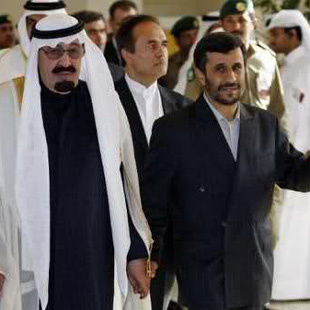Iran & Saudi Conflict of Interest in Bahrain

There have been three fields of competition between these two rivals since 2003. The first is Iraq, second Lebanon, and lastly the Persian Gulf.
-Fields of rivalry between Iran and Saudi Arabia
During the past few decades, the Baathist regime ruling Iraq was considered a positive one by the Saudis, since they thought the Baaths could balance the power in the region against Iran. But after the fall of this regime, a new situation was created in Iraq. The political structure changed in favor of the Shiites since they comprised the majority of Iraqis, and a democratic government in which the Shiites had the biggest role was formed.
But this was not acceptable to the Saudis, and they started to exhibit negative approaches toward Iran’s new relations with the new Iraqi government. They thought that if this new relation reached an important level, the balance of power in the region could turn against them. Accordingly they have expressed no support for the new Iraqi government, and have kept their bilateral relations at a minimum.
In the second field- which is Lebanon- we have also witnessed some developments in the past few decades. Saudi Arabia considers these developments as signs of Iran’s influence in Palestine and Lebanon, and has taken measures to confront this influence. In 2006 a war broke out between Hezbollah and Israel, and in 2008 the Gaza war took place. These developments helped strengthen the axis of resistance in the region while weakening its opponents. In this arena too, the Saudis through their various attempts tried to confront Iran’s influence.
The third area of conflict between these two rivals is the Persian Gulf, which is also the most important area of conflict since it is geographically closer to both countries. We have seen Iran and Saudi Arabia take different stances against the security arrangements of the Persian Gulf in the past few decades. While Iran supported the idea of the security of this region being provided by regional countries, and stood against the presence of trans-regional countries like the US, Saudi Arabia and other Persian Gulf countries opted for the presence of trans-regional countries in the Persian Gulf. They have helped achieve that purpose through different conventions and by providing the US with different military bases in the region the since the 1990’s.
-The Bahrain crisis and the competition between Iran and Saudi Arabia
Due to new developments and popular uprisings, Bahrain has become an important issue in Iran-Saudi relations. Both of these countries have different perspectives on Bahrain. Even though the popular uprisings in Bahrain are considered the continuation of uprisings in Tunisia and Egypt, in actuality their roots are decades old and are due to the discriminatory policies of the government, which does not allow political parties- especially Shiites- to participate in the structures of power.
When the protests in Bahrain escalated and Al-Khalifa was incapable of resistance, the Bahrainis asked the Saudis for help. The Saudis deployed more than a thousand security forces to Bahrain, and they started to crack down on protesters accompanied by Bahraini forces. Currently, Saudi Arabia has a major role among the PGCC members in the crisis in Bahrain. It even seems that the actions of a country like Kuwait, which raised the dispute about Iranian spies, is under Saudi pressure.
Saudi Arabia’s eastern borders with Bahrain have a Shiite population and therefore the Saudis feel a danger if the Al-Khalifa regime is removed and it results in Iran’s increasing influence in this region, in addition to other mentioned areas. Accordingly, even though the uprising in Bahrain is a popular uprising with local roots, it is confronted by accusations of first, Iranian threats and intervention in the country, and second, it is misinterpreted as being a sectarian conflict. The purpose behind these measures is to justify the suppression of the people’s demands and also to gain regional and international support.
It seems that the Saudis will stay in Bahrain to support the Al-Khalifa regime. The Shiites might be given some limited advantages later, but Bahrain’s government will not undertake any serious reforms in the country or accept the fall of the Al-Khalifa monarchy.
-Causes of Tensions
Regional rivalry between Iran and Saudi Arabia has always existed, but tensions arise when a highly sensitive region to both faces a crisis or new developments. The developments in Bahrain happened very quickly and Iran and Saudi Arabia both took positions and acted on them, therefore increasing tensions.
In addition, there is the issue of geographical proximity and the direct benefits to each country in Bahrain. Iran supports the Bahraini people, and Saudi Arabia supports Al-Khalifa, and currently there’s no solution that would enable both countries to achieve their goals.
-Solution to the tensions
The crisis in Bahrain requires measures beyond the framework of Iran-Saudi relations. It seems that the solution is the involvement of regional and international players. As long as regional and international measures are not put into place by countries such as Turkey, Qatar, or even the EU, and the crisis in Bahrain is not somehow resolved, the tensions between Iran and Saudi Arabia will continue. Therefore, for Iran and Saudi Arabia to get pass these tensions, measures must be undertaken by actors other than themselves.

